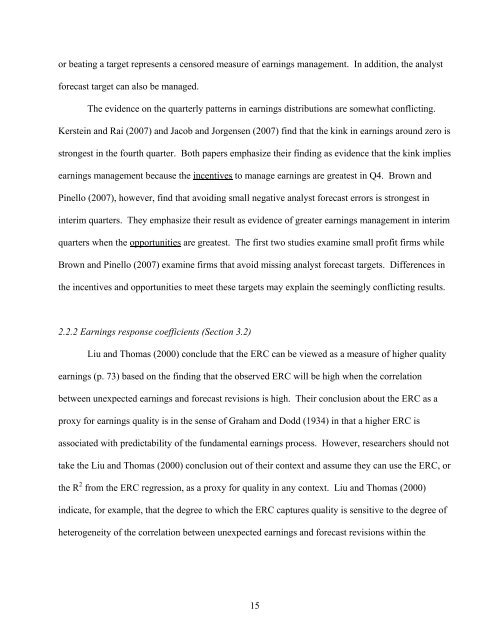Understanding earnings quality - MIT Sloan School of Management
Understanding earnings quality - MIT Sloan School of Management
Understanding earnings quality - MIT Sloan School of Management
You also want an ePaper? Increase the reach of your titles
YUMPU automatically turns print PDFs into web optimized ePapers that Google loves.
or beating a target represents a censored measure <strong>of</strong> <strong>earnings</strong> management. In addition, the analyst<br />
forecast target can also be managed.<br />
The evidence on the quarterly patterns in <strong>earnings</strong> distributions are somewhat conflicting.<br />
Kerstein and Rai (2007) and Jacob and Jorgensen (2007) find that the kink in <strong>earnings</strong> around zero is<br />
strongest in the fourth quarter. Both papers emphasize their finding as evidence that the kink implies<br />
<strong>earnings</strong> management because the incentives to manage <strong>earnings</strong> are greatest in Q4. Brown and<br />
Pinello (2007), however, find that avoiding small negative analyst forecast errors is strongest in<br />
interim quarters. They emphasize their result as evidence <strong>of</strong> greater <strong>earnings</strong> management in interim<br />
quarters when the opportunities are greatest. The first two studies examine small pr<strong>of</strong>it firms while<br />
Brown and Pinello (2007) examine firms that avoid missing analyst forecast targets. Differences in<br />
the incentives and opportunities to meet these targets may explain the seemingly conflicting results.<br />
2.2.2 Earnings response coefficients (Section 3.2)<br />
Liu and Thomas (2000) conclude that the ERC can be viewed as a measure <strong>of</strong> higher <strong>quality</strong><br />
<strong>earnings</strong> (p. 73) based on the finding that the observed ERC will be high when the correlation<br />
between unexpected <strong>earnings</strong> and forecast revisions is high. Their conclusion about the ERC as a<br />
proxy for <strong>earnings</strong> <strong>quality</strong> is in the sense <strong>of</strong> Graham and Dodd (1934) in that a higher ERC is<br />
associated with predictability <strong>of</strong> the fundamental <strong>earnings</strong> process. However, researchers should not<br />
take the Liu and Thomas (2000) conclusion out <strong>of</strong> their context and assume they can use the ERC, or<br />
the R 2 from the ERC regression, as a proxy for <strong>quality</strong> in any context. Liu and Thomas (2000)<br />
indicate, for example, that the degree to which the ERC captures <strong>quality</strong> is sensitive to the degree <strong>of</strong><br />
heterogeneity <strong>of</strong> the correlation between unexpected <strong>earnings</strong> and forecast revisions within the<br />
15
















